#am able to share the clip since it belongs to my collection – reminder of my clownery 🤣🤡
Text
“If she knew about this, she’d be very happy.”
84 Days Until • 李泽言0113生日快乐~ .。*♡
–
Victor telling MC how his mom taught him to make pudding, how MC resembles his mom, and how happy she’d be if she knew how loved her 言言 is 😭❤️

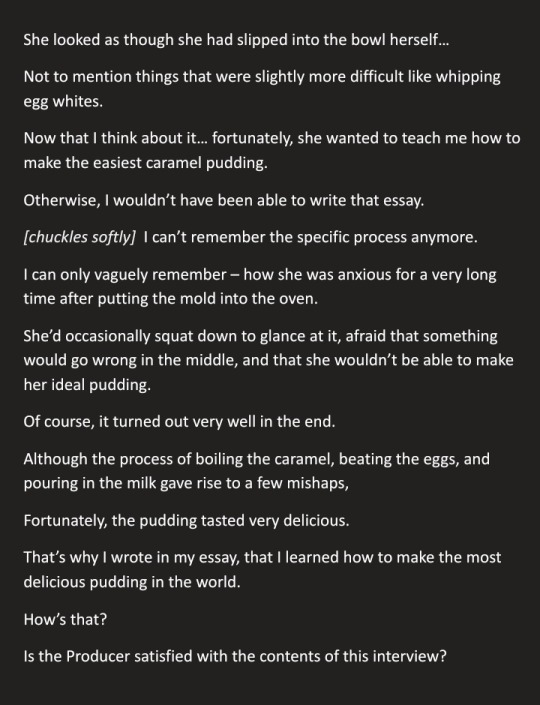
───────────
This line in the grand confession got me so bad, and how she truly does resemble his mom––
“I only need you to be happy, your happiness is my happiness and my everything, As long as it’s granted, I’m willing to give up everything if needed.”
and he goes “YOU are my happiness.” 😭

“[...] Mom doesn’t need you to be thoughtful, well-behaved, obedient. She only needs you to be happy. As far as your mom is concerned, preparing these letters for you one by one, imagining how you would feel when you receive them – the thought itself gives me a kind of subtle joy, as though I’m able to transcend the barriers of time and accompany you on your birthday every year in the future.”

MC: I have also felt lots and lots of happiness.
MC: Your every word, your every look, every moment you appear before my eyes...
MC: And all these thoughts, all these time that I spend in the process of preparing every gift for you...
────────────
#am able to share the clip since it belongs to my collection – reminder of my clownery 🤣🤡#till date one of most fav ASMR. it has so many colors haha. the turn it takes right after skfksjzpwk#mlqc victor#mlqc li zeyan#mr love victor#mlqc#mr love queen's choice#恋与制作人#李泽言#love and producer
65 notes
·
View notes
Text
Woodcuts in suburbia: melancholy, nostalgia, and resistance
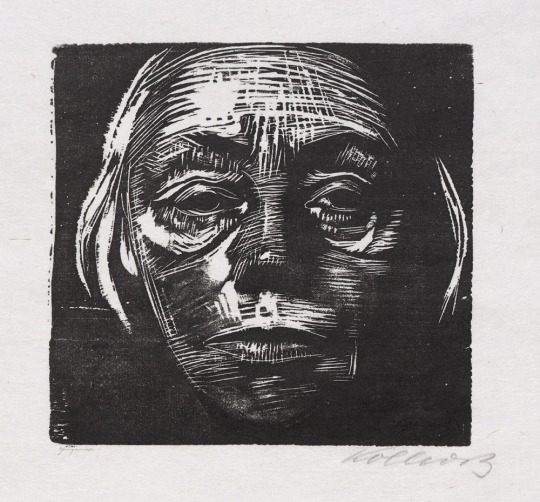
Selbstbildness von vorn, Käthe Kollwitz © 2019 Artists Rights Society (ARS), New York / VG Bild-Kunst, Bonn
I associate woodcuts with a particular aesthetic: they loom from their perch on the bookshelf in the den, next to a collection of Hans Christian Andersen tales, whose worn buckram binding is effusing that sapid antique book aroma which pairs so well with coffee and cake. In the corner of the room, above a worn black leather chair designated for tv-watching and reading, a pathos dangles from its pot, fed by gentle streams of light emanating from the canopy of shade sheltering the backyard garden. On weekends and special occasions, the clinking of cake forks against china is punctuated only by an occasional “delicious!” — direct and accurate. This orchestration produces a distinctly Germanic affect, and one that I associate with the elderly; the particular family room I’m recalling belonged to my next-door neighbors growing up, former members of the Danish anti-Nazi resistance who had emigrated in the early 1960s. While I can’t be sure there was any deeper meaning behind their affinity for the humble woodcut, I do recall the medium’s prominence in their home. For me, something as benign as a flock of geese is represented with a degree of melancholy in these prints' impenetrable black shadows — an inevitability in this generation’s Weltanschauung, that everything beautiful carries with it a degree of pain, a nostalgia for the idea of a more civil world.
These beloved octogenarians were my first choice of role models, and I insisted on seeing them almost every day for the first 8 or 9 years of my life. They were old-school Democrats (or at least, that’s how their values system translated into American) in a largely Republican suburb of a mid-sized Upper Midwestern city. I can still place myself their 1950′s minimal traditional home: running my hands along their walnut furniture with polished nickel handles, greeted by a different antique clock in every room, tick-tocking at various registers, my slippered feet shuffling along a dull, greenish-blue carpet so typical of that era. Nothing in that home was remotely as paired down as today’s sanitized mid-century throwback, and the old neighborhood still retained a smidgen of character unlike contemporary expressions of manifest destiny. Lovingly tended beds of roses, pansies, and bleeding hearts flourished under the shade of maples, walnuts, and red oak.

A young family admires their new home. Between 1950 and 1970, America’s suburban population nearly doubled to 74 million Camerique Archive / Archive Photos / Getty Images
For my neighbors, woodcuts seemed to be a culturally relevant way of displaying eerie alternative landscapes: a flock of geese, a school of fish, a sunset laden with a certain degree of subconsciously expressed Weltschmerz. For me, these woodcuts were inextricably linked to their stories of brazen defiance in the face of terror, which they seldom shared, always with a degree of pain and even embarrassment. Their democratic ideals to which they so proudly clung were the real source of their identity; it was from them that I learned it was OK to be gay, that everyone deserved a home and access to healthcare, that one lives like a society like a neighbor rather than just an individual. But it wasn’t until years after their deaths that I detected any degree of paradox in their suburban American existence, was able to chuckle at their nostalgia for the old country as expressed in their grocery cart (tubs of frozen Coolwhip to be served generously with home-baked apple cake, slices of summer sausage or cucumbers served on squares of cocktail rye, a far cry from the bakeries and delicatessens of northern Europe.)
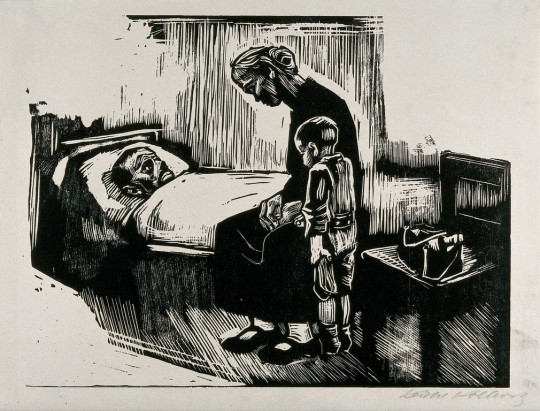
A woman and a boy visiting a man in hospital. Woodcut by Käthe Kollwitz, 1929. Credit: Wellcome Collection. CC BY
While I may associate woodcuts with the interior design choices of an immigrant family in the middle of the last century, its origins predate my concept of history. Woodcutting is thought to be the earliest print technique, originating in 9th-century China, arriving in Europe sometime in the 14th century. Woodcut has been a staple medium for prominent Northern European artists like Dürer since the 16th century. To produce a print, artists carve their image into a block of wood, along the grain, removing the parts that will not carry ink. The surface is then rolled over with a brayer and the image transferred to a sheet of paper through a press. The result in works like Käthe Kollwitz’s Selbstbildness von vorn (1922-1923), pictured above, is nothing short of haunting — well-suited to the violently introspective tone of German Expressionism. If you’re curious about the process, here’s a short demonstration:
undefined
youtube
Phil Sanders, Director of the Robert Blackburn Printmaking Workshop, demonstrates the pressure + ink relief process
Woodcutting became a popular tool of activists in the 1910′s, when thinkers like Ernst Barlach were beginning to use reductionist, anti-naturalist figures to express their dejection at the rise of an alien world. In the case of Barlach, his art was often placed alongside politically charged writing in order to provoke emotional reactions to the realities of uprootedness, inequality, and disaffection in industrialized, urban Europe. It is Barlach’s rather proletariat answer to the questions of modernity, inspired in part by a kind of political realism emerging in Russia, that inspired German artist Käthe Kollwitz to take up the humble woodcut.
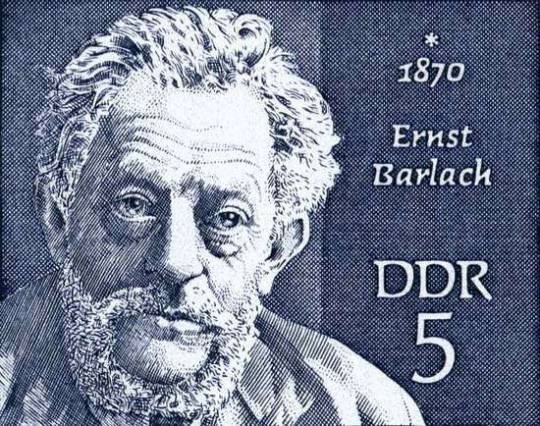
Ernst Barlach, from an East German stamp, 1970. Would he have been pleased with his legacy?
I remember receiving a story on the couch in my neighbors’ den — I was about 10 or 11 — regarding the final days of the war: a fellow member of the resistance had suggested replacing the Dannebrog with the flag of the Danish Communist Party, the DKP, an idea that had shaken my neighbor to his core. For him, resistance had been an act of preservation, a defense of the right to be distinctly Danish, and all that it entailed, in an increasingly international world. How the inability to return to a Denmark before the crimes of Nazism must have felt, I can only attempt to imagine. To this day, I am astounded by my neighbors’ apparent lack of burnout in light of what they sacrificed, their resilience in living out their ideals and inherited melancholia with me under an umbrella on the patio. It seemed that, for them, past and present far outweighed considerations for the future.
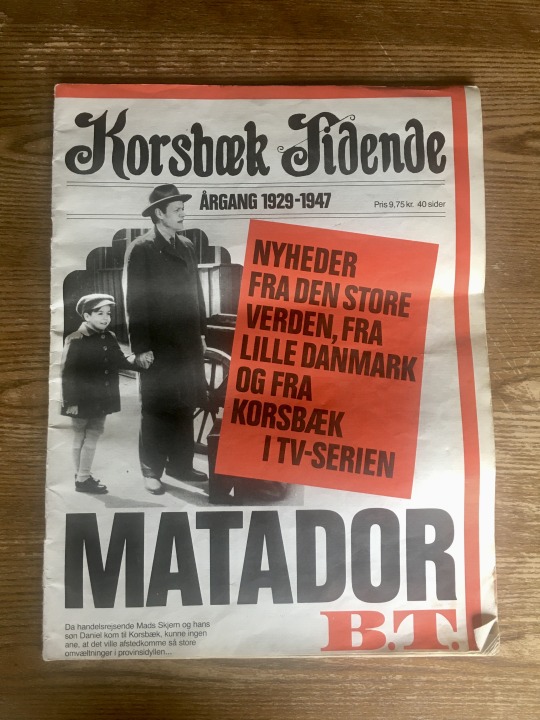
My copy of Korsbæk Tidende (Korsbæk Official Journal), an educational accompaniment to the popular Danish 1970′s and 1980′s tv-series “Matador” about a fictionalized Danish town between 1929 and 1947. I inherited this collection of real newspaper clips that informed events on the show from my neighbor — I assume he loved the show.
To an extent, I have inherited their idealism, an obsession with a bleak past used to check the present, an index of unwavering values to be accessed at any time. It is only through a sense of history that I’m able to make sense of the communicative power of images today, how calculated distortions of reality made ubiquitous through mass production can make us more empathetic, braver in the face of a not-so-distant future. It's a future that cannot be understood with the tools we have been given, that will almost upend our perceptions and unsettle us, a future that demands our bravery. More than ever my beloved neighbors ever could have fathomed, the possibility that our sacrifices will be bastardized in the name of another cause is unparalleled in the digital age. And even more than they experienced, we have the incredible opportunity, and challenge, to transplant our ideologies across ecosystems, upending heir original contexts.
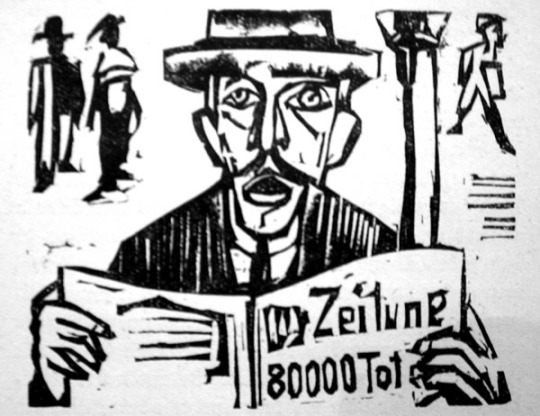
Simultaneous calls for universalism and individual freedom, the appeals of difference and homogeneity, the cogent argument of moral relativism against the call for a shared global narrative will, no doubt, continue to shake us in an era of unprecedented displacement and global climate change. Among other things, these challenges call for an art that, like the pervasive woodcut, infiltrates our purviews, and is attuned to the affect of contemporary life. It should carry with is a melancholic nostalgia, demand our empathy, blemish our idealized beauty.
If I limit myself to woodcuts, I'm reminded of the works of William Kentridge, Beatriz Milhazes, Leonard Baskin, Alison Saar, Irving Amen, Tony Bevan, Katsutoshi Yuasa, Assadour Bezdikian, Elizabeth Catlett, Lou Barlow, Leon Gilmour — I'm sure I'm missing countless others.
Retrospective Exhibitions on Käthe Kollwitz
Käthe Kollwitz, National Gallery of Art, Washington, D.C., 1992; Käthe Kollwitz: In Celebration of the 125th Anniversary of the Artist’s Birth, Galerie St. Etienne, New York City, 1992; Berner Kunstmuseum, Bern, Switzerland, 1946; Retrospective in honor of her 50th birthday at Paul Cassirer galleries, Berlin, 1917
Selected Bibliographies on Käthe Kollwitz
Knesebeck, Alexandra von dem. Käthe Kollwitz: Werkverzeichnis der Graphik. Band I & II. Bern: Kornfeld, 2002.
Prelinger, Elizabeth, ed. Käthe Kollwitz. Exh. cat. Washington, DC: National Gallery of Art, 1992.
Rix, Brenda D., and Jay A. Clarke. Käthe Kollwitz: The Art of Compassion. Exh. cat. Toronto: Art Gallery of Ontario, 2003.
Selected Bibliographies on Ernst Barlach
Laur, Elisabeth. Ernst Barlach: Sämtliche Werke, Werkverzeichnis I. Die Druckgraphik. Leipzig: E. A. Seemann, 2001.
Paret, Peter. An Artist Against the Third Reich: Ernst Barlach, 1933–38. Cambridge: Cambridge University Press, 2002.
Selected Bibliographies on Ernst Ludwig Kirnchner
Dube, Annemarie, and Wolf-Dieter Dube. Ernst Ludwig Kirchner: Das graphische Werk. 2 vols. Munich: Prestel, 1980.
Gercken, Günther, and Magdalena M. Moeller. Ernst Ludwig Kirchner: Farbige Druckgraphik. Exh. cat. Berlin: Brücke-Museum, 2008.
Krämer, Felix, ed. Ernst Ludwig Kirchner: Retrospective. Exh. cat. Frankfurt: Städel Museum, 2010.
Lloyd, Jill, and Magdalena M. Moeller, eds. Ernst Ludwig Kirchner, 1880–1938. Exh. cat. Washington, DC: National Gallery of Art, 2003.
Wye, Deborah. Kirchner and the Berlin Street. Exh. cat. New York: The Museum of Modern Art, 2008.
1 note
·
View note
Text
Labeling 101: Quick & Easy Labeling Techniques
I am back with part three of a four post series I have put together with the best of the IHeart Organizing best. It's been a long time coming to take everything I have learned over the years, whether it is working in my own home or working with others, and compiling it all in a single place here on the web.
The four-part series will include:
Gearing Up for Your Next Organizing Project with a FREE Printable Kit!
Need helping getting started or prioritizing where to begin? What is the plan of attack? What is currently working well and what isn't? What storage do you need? Trying to get rid of things, but finding it hard to decide what to keep and what to pass on?
I have put together a great printable kit to help you prioritize, sort, and navigate your way through your next organizing project(s), which includes a total of TEN free printables!
FIND THAT POST HERE!
My Top Organizing Tips!
Instead of digging through years of my archives to find individual tips, I am going to compile the best of the best in a single, very informational post! It's going to be a whopper and a really great resource for projects of any size.
FIND THAT POST HERE!
Labeling 101: Quick & Easy Labeling Techniques
I have tried almost every type of label on the market, from vinyl to label makers to stickers and chalk markers, and they all have their place. But what are my tried and true favorites? What do I reach for with almost any project due to time, cost, practicality, and ease? I will be sharing three labeling techniques that haven't failed me yet, and that you won't need any fancy tools to utilize.
Practical, Everyday Storage Solutions!
If I have learned anything from raising three boys and organizing along the way, it is that storage can be expensive and that our needs are constantly evolving. Gone are the days where I purchase pretty bins and baskets to decorate with. Although I will always appreciate beautiful storage, it has to be versatile and it has to last! With that in mind, there are a few storage products that I have found that continuously work hard for me in a variety of situations, so they end up being the types of products I gravitate toward when working on any new projects. For the final post in the series, I am putting together the ultimate storage source list with tips and products that I have fallen in love with over the years.
So let's dive in with part three of the four-part series: Labeling 101: Quick & Easy Labeling Techniques.

I have always enjoyed the creative side of organizing, and labeling has really allowed me to play with a variety of craft tools, papers, vinyl, and embellishments. Labels can really add to the overall aesthetic of a project while being extremely useful at the same time!
There are times that I may decide to invest more time and energy into the creative process of an organizing project, but for the majority of my projects I have THREE tried and true labeling techniques.
However, before I dive in and talk about those methods, let's quickly go over the reasons behind WHY we label in the first place.
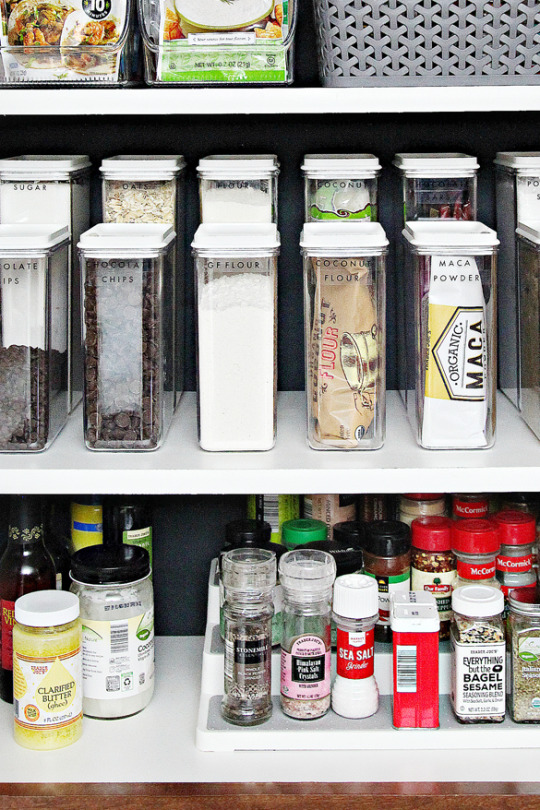
Labeling is definitely a personal preference that doesn't have a one-size-fits-all rule.
The overall purpose of labeling is to create easy identification. Generally speaking, it is best to label for safety purposes or to keep your household on the same page:
Label food containers to indicate a specific ingredient (or lack of ingredient) due to allergies and sensitivities.
Label food containers/leftovers with dates to prevent serving expired and spoiled consumables.
Label to indicate if an item is fragile or hazardous.
Label to identify the contents of a solid container or bin.
Label to differentiate multiple items that appear similar.
Label to help children identify where to find things/put things away (toys, snacks, clothing, etc...).
Label to identify the possession of items between household members.
Label to create consistency or understanding between household members.
Again, it really comes down to how your household functions and the dynamic of everyone who resides there. Labels can be extremely helpful but are not always necessary.
I use to label clear pantry containers and fridge containers with the contents, only to change the contents each week with my grocery shopping. Changing the labels became too much maintenance and we really weren't gaining much by labeling the obvious clear bin of crackers, as "crackers". So I stopped. Now, I quickly add the purchase date on the bottom of the container with a dry erase marker and call it good (unless it is allergy specific of course). If a label is causing extra work, then is it really adding value?
That said, we have benefitted greatly by labeling over the years. Having a household of five, labels have really made it easy for all of us to collectively pick-up and get things back to their proper homes, and also identify our personal belongings to avoid mix-ups. And by labeling cleaners, drawers, bin contents, etc..., I avoid a lot of questions from my crew.
OK, so now you are ready to start labeling, but what are the best methods? Here are three that haven't failed me yet!
LABEL MAKER
This one is obvious but also the most important. I used this label maker for many, many years, but after a few drops, it broke and I was left scrambling to replace it. It doesn't seem to be available any longer (because the prices on it have since skyrocketed), so I shed some tears and set out to find something similar. I am not too picky, I just wanted something that was inexpensive, had a couple font options, offered clear labeling tape, and also offered inexpensive replacement cartridges. I also appreciate something battery operated/portable so that I can use it quickly and easily without any additional accessories.
I decided on this Brother P-Touch option, I found it for under $20 and the value is definitely there! I have been liking it so far, it checked all of my boxes and I really appreciate that it is an extremely flexible and affordable option. I was also able to find some off-brand tape options on Amazon, and they have also worked out really great! (I purchased these white on clear and these black on clear cartridges). I find this label maker to be really user-friendly, the font options are OK, it prints quick, and the labels stick well yet are also removable. All around a good, go-to option.
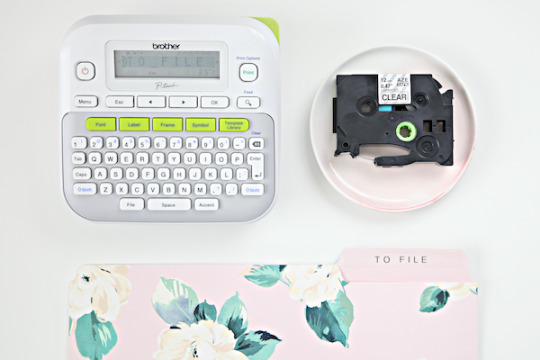
Label makers are the clear choice for almost any organizing project because they are quick to use, easy to create, and can adhere to just about anything. I have also found that most label tapes are semi-waterproof, so they can take light cleanings and handle being in kitchen/bathroom settings. Here are a few ways I use my label maker around our home:
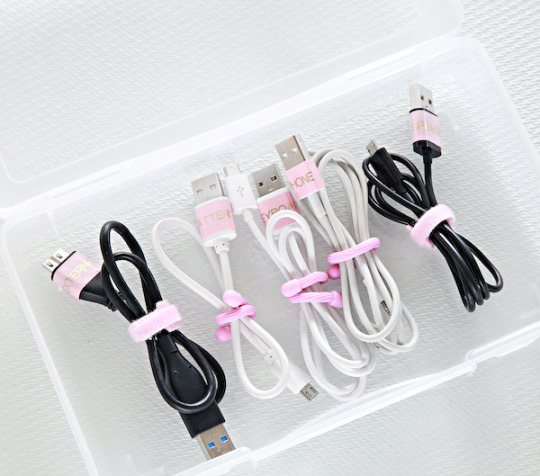
Labeling Cords: Wrap around the base of the cord to identify what gadget/person the cord belongs to.

Labeling Cleaning Bottles: Because I make most of our cleaners, I use my label maker to identify the type of cleaner and the general purpose. And because they are semi-waterproof, they can hold up to frequent use and refills.

Labeling Canisters: Perfect for labeling baking powders and coffee beans/add-ins, as well as specialty food items.

Labeling Shelves/Drawers: This has helped my boys tremendously in putting things back where they belong and keeping some general order around our home.

Travel Toiletries: Label tape wraps perfectly around those small, clear travel bottles that constantly need refilling. And because face wash looks like shampoo and lotion looks like conditioner... well, you know how that could result in a bit of a morning disaster.

Spice Jars: If you transfer your spices to jars, label tape is a great way to identify the different varieties.

File Folders: For file folders that I reuse for the same purpose over and over, I love the look of label tape over my handwriting any day.

As you can see, I gravitate towards the clear label tape because I find that it gives a very seamless look. For some reason, the white label tape reminds me of daycares, office spaces, classrooms, and Dr. offices, which is not necessarily a bad thing, it just feels more commercial than personal.
ADHESIVE LABEL HOLDERS
There are quite a few times when I want to add labels, but I am looking for a more polished, long term effect. This is generally in spaces that we see and use often, or for items that are typically left out in the open. In these situations, I use an adhesive label holder, and then just print out the actual label to slip inside. The holder just sticks right to the surface, making it another fairly quick and easy labeling solution.
The two styles I use are the Martha Stewart Bookplates and the Bigso Adhesive Label Holders.




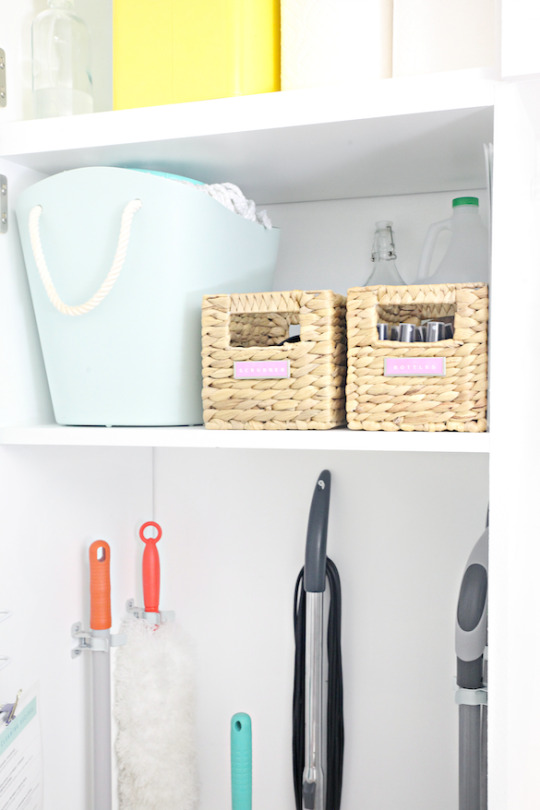



Just like label tape, these label holders are adhesive and fairly versatile. I typically use them on bins and boxes that either have a rougher surface or in situations that label tape would get lost due to the shape and size of the container (because you can print your own labels, you can design the color/font to be sure they really stand out). These work well on the infamous Target Y-Weave baskets, common rattan baskets, as well as on canvas style bins. If you ever find the stick is fading, a little hot glue can give the holder new life. The narrow options also work really nicely on the face of shelves.
CLIP-ON LABEL HOLDERS
Last but certainly not least, clip-on label holders are becoming a new favorite! They are a really great size which makes them a perfect solution for labeling larger bins and baskets. They couldn't be easier to use, straight from the package they literally just clip right to the container. For bins receiving a lot of use (think toys, linen closet, tool storage, etc...), these are big winners because they are really substantial and won't fall off easily. Yet, they are completely reusable/not at all permanent.
I find these great clip-on holders at Target and The Container Store.


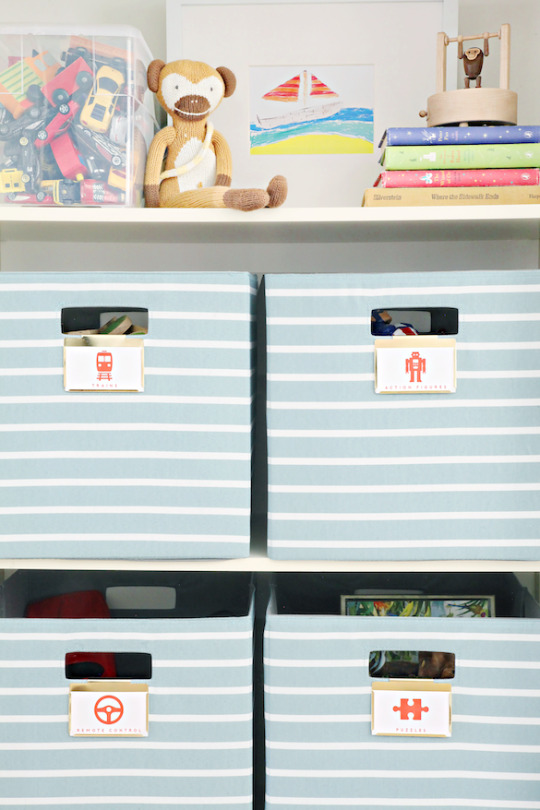
These holders are especially great for large baskets of children's toys, as the surface offers enough space to print an entire image of the product inside for easy identification. Because our kids are older and we don't have many toy bins any longer, I like to use these on woven baskets in cabinets and closets, on canvas bins, and for our tool bins in our storage room.
_______________
Now that I have covered my top three favorite ways to label, I thought I would chat really quickly about vinyl! I still receive a lot of questions on oldie posts about my vinyl labels, which I would create at home and cut with my Silhouette craft machine. I will always love the look that making these labels offer, but I find myself reaching for the machine less and less due to the mess it makes and time constraints. There will always be a place in my heart for vinyl lettering, I especially appreciate that it is extremely durable, waterproof, and can look really, really sharp. Below are a few examples of how I have used vinyl labels around our home:
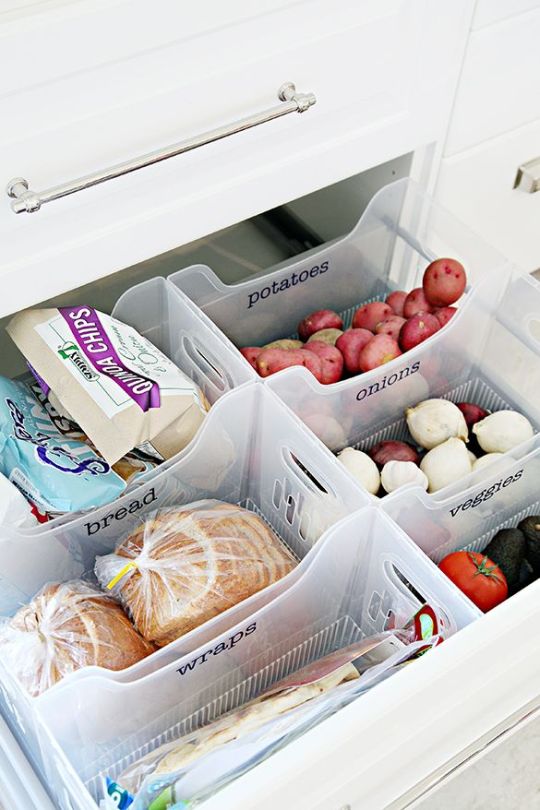



I wanted to share one last time-saving labeling technique in the kitchen. Dry erase/chalk markers! I can use them to write on our clear plastic and glass containers, and then erase the writing if the contents change. I usually use markers to add dates to leftovers or dry goods to show when the product was purchased, and also call out items that may have specific food sensitivity information. It gets the job done and just wipes away each time we change out the foods inside.


!function(d,s,id){var e, p = /^http:/.test(d.location) ? 'http' : 'https';if(!d.getElementById(id)) {e = d.createElement(s);e.id = id;e.src = p + '://' + 'widgets.rewardstyle.com' + '/js/shopthepost.js';d.body.appendChild(e);}if(typeof window.__stp === 'object') if(d.readyState === 'complete') {window.__stp.init();}}(document, 'script', 'shopthepost-script');

JavaScript is currently disabled in this browser. Reactivate it to view this content.
Only one more post remains in this super-sized series! Last up we are talking all things storage!
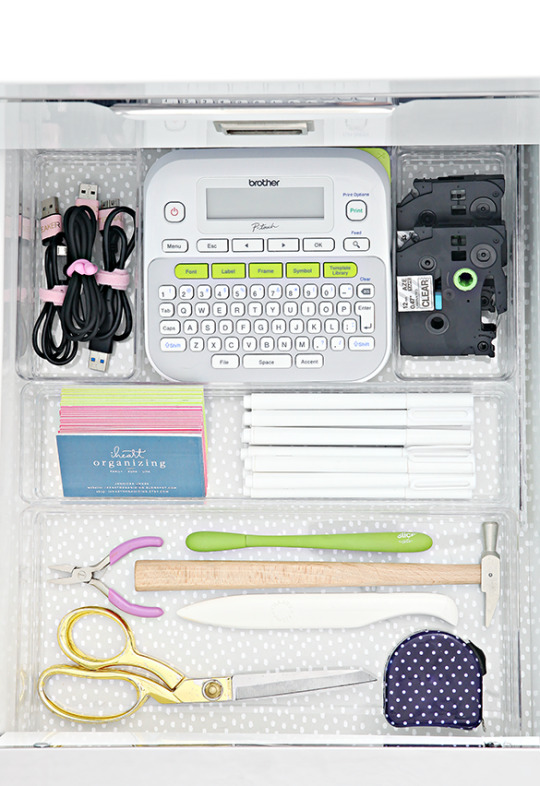
from IHeart Organizing http://www.iheartorganizing.com/2019/05/labeling-101-quick-easy-labeling.html
0 notes
Text
Colorado Poet Diana Khoi Nguyen Shortlisted for National Book Award
Colorado Poet Diana Khoi Nguyen Shortlisted for National Book Award
Ghost Of is Diana Khoi Nguyen’s remarkable award-winning poetry debut; this collection is an extensive, jarring rumination on the loss by suicide of her younger brother — the ghost and principal muse of the work. Nguyen’s voice is augmented by family photographs which combine with her poetry to produce innovative multi-media forms; these give a deconstructed dimensionality to her tender lamentations. The result is nothing short of ingenious and sincere vulnerability, a portal into deeply personal histories.
Diana Khoi Nguyen’s work is assuredly appreciating a much larger audience thanks to its most recent acclaim. After examining the initial longlist of ten poets nominated for the National Book Award in Poetry one might notice that Diana Khoi Nguyen is one of three debut poets, one of two poets published by small presses, and the only Coloradan poet of the total ten poets nominated on the longlist. The shortlist was announced today, and Diana’s Ghost Of is one of five total nominees; the other finalist nominees for the award:
Rae Armantrout, Wobble
Wesleyan University Press
Terrance Hayes, American Sonnets for My Past and Future Assassin
Penguin Books / Penguin Random House
Justin Phillip Reed, Indecency
Coffee House Press
Jenny Xie, Eye Level
Graywolf Press
I initially interviewed Diana as a part directly following her work’s release in April (read the article here); following this news, Diana agreed to further inquiry and discussion of her artwork.
I’m sure receiving news that your debut poetry collection Ghost Of is nominated for the National Book Award has been a landmark moment for your career as an emerging writer. Can you describe your overall reaction to the work’s nomination?
It is embarrassing to admit that I immediately burst into tears while walking two dogs: one big, one small. The news came to me indirectly via simultaneous multiple texts from different friends congratulating me — I was confused, then checked the internet and burst into tears. Tears of gratitude for the work connecting with strangers beyond my imagination, tears of relief, a marker that I was underway in a major goal of my life: a serious dedication of life efforts to an attempt at art-making.
The subject matter of Ghost Of is profoundly personal. As a poet, how do you react to such raw vulnerability being shared on such a public scale?
With extreme discomfort. It’s a conscious, constant push to be comfortable — because there is growth in the process. It was my intention to share this personal and familial grief in a poetry-public way with the hope of connecting with others-in-grief. To feel less lonely, to belong via words, the imaginations of others.
How has writing Ghost Of affected your grieving process?
It is the grief process, part of it. Writing it enabled me to unlock the emotions I had kept dammed for over a year since Oliver’s death. I sobbed throughout the writing of the triptychs, and return to that emotional state every time I read those poems at readings. Weeping is not something I am fearful of, as I did previously; it’s a reminder I’m able to feel, strongly.
At times, Oliver’s clipped absences from family photos are filled with poetry that speaks directly to him. Can you describe the process and perhaps the after-effects of reaching toward your brother in these moments?
In the months after his death, I felt immobilized, devoid of any discernible feeling. Two years prior to his death, he had cut himself out of family portraits that hung on the walls of our family house, terrible harbingers of what was to come: he cut himself out of photos before finally cutting himself out of the fabric of life. The marred photos hung in the walls after the cutting, and also after his passing — terrifying representations of death. Around the time of the first year anniversary of his death, I forced myself to confront these images face to face. I scanned them, sat with them well into the late hours of the evening, and immense emotion swelled inside me. There was this desire to reclaim the artifact, to drain them of their awful power: I began to fill them in, to speak to my brother in ways I wish I had years before his death, before he cut himself out of frames. Doing so helped unleash our shared lifetime of emotions, memories, and histories — it was a way to be with him in the past, present, and future (if the dead have a future).
In our last interview you mentioned you were a poet by necessity, because “[you] can’t not write.” As a poet of compulsion, what is it that compels you to the page again and again?
Routine, habit. Twice a year: once in summer and once in December (around the anniversary of his death), I write in 15 poem-a-day marathons with close friends around the country — as a forced, pressurized praxis. As someone who is prone to being an object at rest, I believe I would never write a poem if it were not for this biannual marathon. Yes, I can’t not write, but it’s also really hard to write, so this praxis helps bridge the gap.
The road to success, especially for emerging poets, is an often frustrating, mysterious process fraught with rejection. How did you navigate the publishing process to get to this point? What advice do you have for other writers working on debut works?
I did and still do think of it as a filing of taxes; apply for every opportunity and submit to as many places as you can, given emotional, financial, temporal (and other) resources. Apply, submit, and forget you did so. When (and it is a when) good news comes, the surprise of it is bright. Try not to fall into that vortex of obsessively worrying about possible rejection, etc. I wish good feelings at all times, for all persons. We cannot make acceptances happen, but we can fold the uncertainty of submission into a positive way of being. Self-care first, but never stop filing your poetry taxes.
The National Book Award category in Poetry is an essential category that acknowledges the achievement of poets and the importance of poetry. The category disappeared altogether for the years 1990-1991. In a political climate where funding for the arts are being cut left and right, what words do you have advocating for the vital importance of its continued support?
While poetry may not appear as essential as those matters which directly enable physical and emotional safety and security, I would argue that poetry — and the arts in general — are crucial to the safety and security of all persons in a nation, especially one as divided as ours today. Art captures subjectivities, personal, familial, and social histories — reminding us to feel, to wonder, to hold in our minds the shared imagination of another. Art distinguishes us as a sentient species.
The 69th National Book Awards Ceremony will be held on November 14th.
To read the collection’s namesake poem “Ghost Of” click here.
Purchase your copy of Ghost Of here.
from Blog https://ondenver.com/colorado-poet-diana-khoi-nguyen-shortlisted-for-national-book-award/
0 notes